Jun 2013
New drawings discovered
30 June 2013
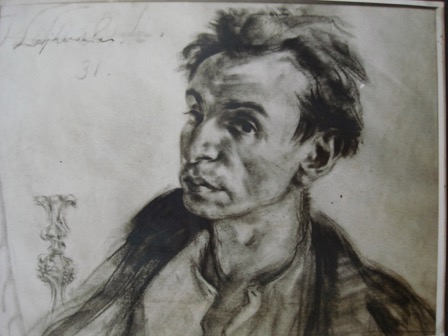 Courtesy Ephraim Margolin, California, USA
Courtesy Ephraim Margolin, California, USADuring the last few days, a number of photographs of lost works have turned up in private collections in California. The largest and most exciting discovery was a portfolio album of photographs of many paintings and drawings prepared by Lejzerowicz in the summer of 1938 as a remembrance to present to his friend and patron, Ewa Spektor Margolin, when she returned to Poland from Tel Aviv for a summer visit. Lejzerowicz stayed with the Margolin family in Wiśniowa Góra. The drawing above, dated 1931, shows the young artist in a lively moment. Lejzerowicz put this drawing first in the album he presented to Ewa Spektor Margolin. Other works (most of which no longer exist to the best of our knowledge) included photos of pictures of his mother as well as an image of the painting he did of Ewa herself, the original of which hung in Dr. Julius Margolin’s (Ewa’s husband) apartment in Łódź. Julius stayed behind in Łódź while sending his wife and son to Palestine in 1936. Julius was due to join them in September 1939, but the war intervened; he couldn’t join them permanently until 1946 - following many years in a Soviet labor camp.

Wiśniowa Góra
24 June 2013

In the mid-1930s, Lejzerowicz accompanied the extended Margolin-Spektor family to Wiśniowa Góra, a rural area in the countryside east of the city, for periods of time in the summer. In this quiet setting, he must have enjoyed sketching and painting as well as much conversation with his hosts as they took pleasant walks in the woods. Today, the area known as Wiśniowa Góra retains a delightful charm with many wooden houses dating back to the early years of the twentieth century; then as now, it is a refuge from the noise and busy life of industrial Łódź.


Rybna 14a, Łódź
21 June 2013

The Łódź ghetto was established by the occupying German military as of February 8, 1940, although planning was already underway in December 1939, two months after the invasion. The ghetto was sealed off on April 30. The city’s large Jewish population was forced to move into an area in the poorer, northern section of the city called Bałuty, which had poor drainage and infrastructure. All non-Jews were required to leave. Starting in 1930, the Yiddish-language writer Izroel Rabon starting publishing a serialized novel in the Yiddish daily Lodzer Togblat depicting life in this part of town. Rabon’s novel, Balut*, gives an excellent idea of life among poor Jews in the neighborhood.
Like all other Jews in the city, Izrael Lejzerowicz moved to Bałuty during this period, bringing his elderly father with him. It is unclear how or why he came to live in the building at Rybna 14a, a corner building with a shop on the ground floor and a large courtyard in the center, typical of buildings in Łódź. One elderly survivor who lived in the building during the ghetto period reported a few years ago that he had taken the initiative to scout out the neighborhood for possible apartments for his family and grabbed one at Rybna 14a as soon as he could, rather than wait to be assigned a space by the authorities. Perhaps Lejzerowicz did the same, as the building has both large and small apartments and was in comparatively good condition. For a painter, a studio with good windows was basic to any hope of working. And working meant the possibility of survival. From the beginning that was already evident.
An unofficial count of people who lived at Rybna 14a during the ghetto period numbers some 320 individuals from all walks of life: artist painter, baker, bank employee, barber, bookkeeper, brush maker, building superintendent, cabinetmaker, capmaker, civil servant, cutter, darner, dealer, editor, engineer, farmer, fireman, fitter, glove-maker, hand-sewer, housewife, knitter, laborer, manufacturer, merchant, midwife, nurse, office clerk, office worker, packer, painter, paperhanger, plumber, porcelain painter, quilter, rabbi, schoolchild, seamstress, seminary student, storekeeper, sugarmaker, tailor, tanner, thread-twister, trainer, washerwoman, weaver.
It was in his studio in this building - which still stands today - that Lejzerowicz hosted a writers’ group that met periodically. The original owners (Polish Christians) returned after the war when they were allowed back into the neighborhood. When they returned, they found the building nearly in ruins: anything that could be sold or burned for fuel had been ripped out. Over the succeeding years, they managed to restore the building and bring it back into use.
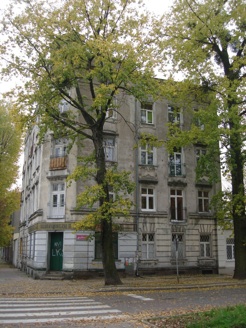
*Although incomplete, the novel was republished in a French version in 2006 as Balut, roman d’un faubourg. Montreuil, France: Editions Folies d’encre.
More about Jana Kilińskiego 49
20 June 2013
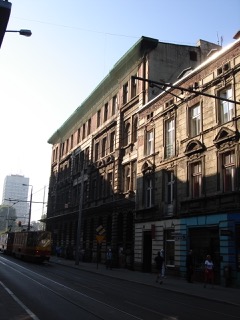
The building in which the Lejzerowicz family lived - and where Izrael seems to have had his studio during the 1930s - is a grand old building that is still standing today in the center of town. Alas, it’s now more of a standing ruin, but people still live there and probably some of the apartments are quite beautiful. The city is full of glorious buildings erected before World War I. For many years after 1945, there was little chance of restoring them, but now many of these older buildings are being saved and restored one by one.
This building was important to the Jewish community in Łódź. The last Jewish school in the city, the Perec School (featured in Sławomir Grünberg’s documentary film, The Peretzniks / Perecowicze) was in this building until it closed after the anti-Semitic campaign of the Polish government in 1968.
Lejzerowicz’s sister, Estera, ran a school in the building for a period in the early 1930s.
Today, the courtyard looks like a set for a Beckett play, complete with a spindly tree ready to be part of the set for Waiting for Godot. As the city reclaims its older buildings, we can hope that someone will see the beauty and possibilities in this one, provided that its structure is sound enough to permit restoration.

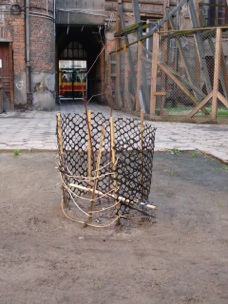
At home in Łódź in the 1930s
19 June 2013

This charming snapshot shows the two grandchildren of Lejb and Ruchela Lezjerowicz. On the right is Ruth Leiserowitz, daughter of Samuel / Szmul visiting her grandparents for the first time from her home in Berlin sometime after her grandmother’s death in March 1934. Ruth now lives in the United States. On the left is Gabriel Lasman, the son of Estera Lasman, née Lejzerowicz. Gabriel perished in the Holocaust, probably in Warsaw according to family members. On the wall behind them are paintings, now lost, by Uncle Srulek, i.e., Izrael Lejzerowicz. The bust on the little table is also by him and represents the only evidence of the artist’s work as a sculptor.
Family picture, courtesy Ruth Lewis (formerly Ruth Leiserowitz), Maryland, USA
A Lejzerowicz Blog
14 June 2013
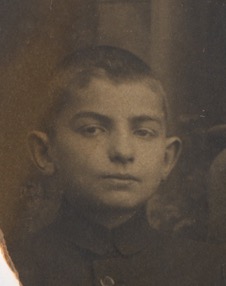
This is the earliest picture we have of Izrael Lejzerowicz - taken around 1910 if we imagine this is a boy of 7 or 8. It’s in a family portrait that includes the only known picture of his oldest brother, Abram, who died of peritonitis sometime before or during World War I.
Perhaps the child Lejzerowicz will help this child blog grow into something interesting for all. Help me do that...
Family picture, courtesy Ruth Lewis (formerly Ruth Leiserowitz), Maryland, USA